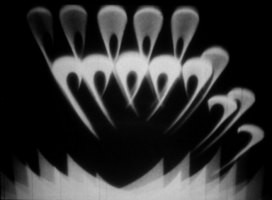Stefan and Franciszka Themerson
02 May - 28 Jun 2009
Stefan Themerson (Płock, Poland 1910 - London 1988) and Franciszka Themerson (Warsaw 1907 - London 1988) met in Warsaw in the late 1920s, married in 1931, and went on to have a significant influence on the art and philosophy of the avant-garde of Eastern Europe during the 1930s. They are considered to be the most important experimental film-makers in pre-war Poland. They moved to Paris in 1938, but after the outbreak of the second world war Franciszka escaped the German invasion and fled to London in 1940. Stefan followed in 1942.
They produced five films in Poland between 1930-1937 (Pharmacy, Europa, Moment Musical, Short Circuit, The Adventure of a Good Citizen) and made two films (Calling Mr Smith and The Eye and the Ear) for the film unit of the Polish Ministry of Information and Documentation while in exile in London during the second world war. Only the last three, presented in this Lightbox display, have survived. The remarkable collaboration, invention and technical experiment that distinguished their career extended to a broad range of interests from film, photography, literature and art to design and publishing.
The Adventures of a Good Citizen
Warsaw, 1937, sound, B&W, 10 minutes, music by Stefan Kisielewski
The Adventures of a Good Citizen is the only survivor of the Themersons' pre-war films. Thought to be lost during the second world war, one old and badly battered print was found near Moscow and sent to the Film Archive in Warsaw. This complex cinematic collage uses live action, transformed in various ways, unconventional takes, and abstract effects painted directly on the film.
Calling Mr Smith
London, 1943, sound, Dufay-colour, 10 minutes
This rallying call to open the eyes and minds of the British public to Nazi atrocities in Europe is an expression of genuine loss. Photographs and fragments of film footage shot as war documentation appear on the screen accompanied by flashes of coloured lights. Musical fragments of pieces from Chopin, Bach and Szymanowski are dramatically contrasted with the infamous anthem of Hitler's legions, the Horst-Wessel-Lied.
The Eye and the Ear
London, 1944-45, sound, B&W, 10 minutes
A return to the Themersons’ quest for a purely filmic language, The Eye and the Ear reflects their desire to produce a visual equivalent to music. Through a variety of means, such as the ripple effect of small clay balls dropped into water and the passing of light beams through a special lens, they create visual interpretations of four songs from Karol Szymanowski’s Słopiewnie. The geometrical forms of The Eye and the Ear are also accompanied by images of Piero della Francesca's Nativity, which serves as a background to the abstract patterns. The Themersons treated the film medium as a tool for the analysis of musical structure.
They produced five films in Poland between 1930-1937 (Pharmacy, Europa, Moment Musical, Short Circuit, The Adventure of a Good Citizen) and made two films (Calling Mr Smith and The Eye and the Ear) for the film unit of the Polish Ministry of Information and Documentation while in exile in London during the second world war. Only the last three, presented in this Lightbox display, have survived. The remarkable collaboration, invention and technical experiment that distinguished their career extended to a broad range of interests from film, photography, literature and art to design and publishing.
The Adventures of a Good Citizen
Warsaw, 1937, sound, B&W, 10 minutes, music by Stefan Kisielewski
The Adventures of a Good Citizen is the only survivor of the Themersons' pre-war films. Thought to be lost during the second world war, one old and badly battered print was found near Moscow and sent to the Film Archive in Warsaw. This complex cinematic collage uses live action, transformed in various ways, unconventional takes, and abstract effects painted directly on the film.
Calling Mr Smith
London, 1943, sound, Dufay-colour, 10 minutes
This rallying call to open the eyes and minds of the British public to Nazi atrocities in Europe is an expression of genuine loss. Photographs and fragments of film footage shot as war documentation appear on the screen accompanied by flashes of coloured lights. Musical fragments of pieces from Chopin, Bach and Szymanowski are dramatically contrasted with the infamous anthem of Hitler's legions, the Horst-Wessel-Lied.
The Eye and the Ear
London, 1944-45, sound, B&W, 10 minutes
A return to the Themersons’ quest for a purely filmic language, The Eye and the Ear reflects their desire to produce a visual equivalent to music. Through a variety of means, such as the ripple effect of small clay balls dropped into water and the passing of light beams through a special lens, they create visual interpretations of four songs from Karol Szymanowski’s Słopiewnie. The geometrical forms of The Eye and the Ear are also accompanied by images of Piero della Francesca's Nativity, which serves as a background to the abstract patterns. The Themersons treated the film medium as a tool for the analysis of musical structure.

